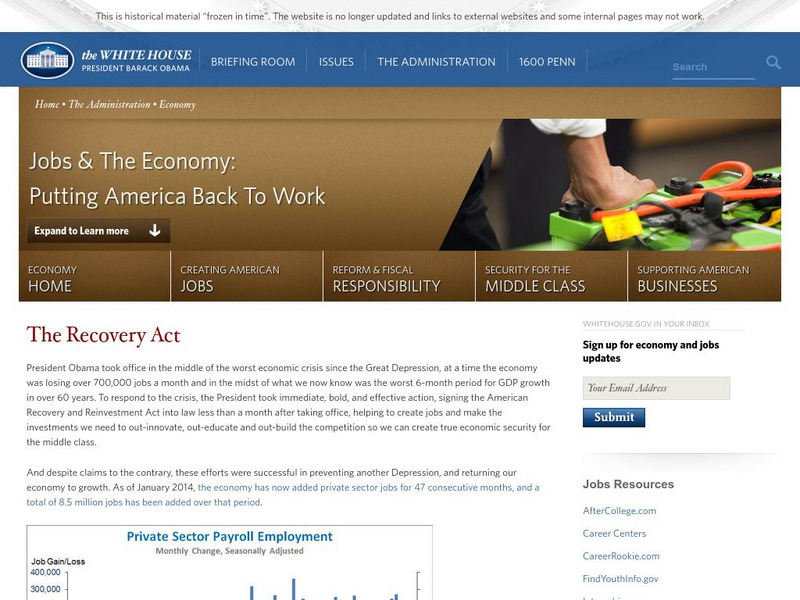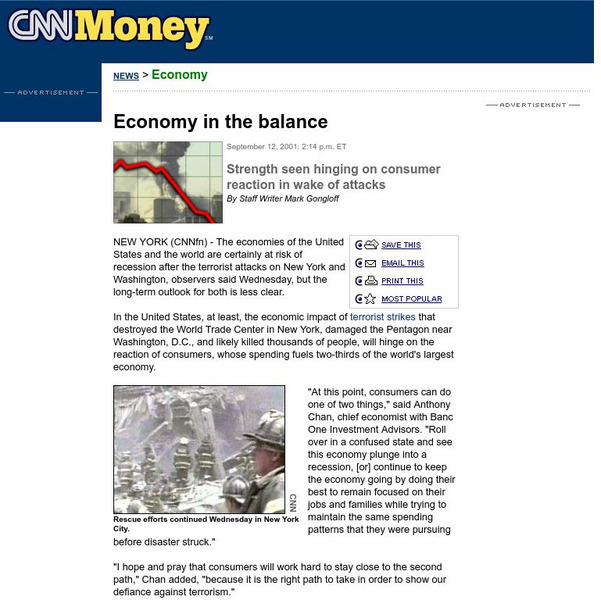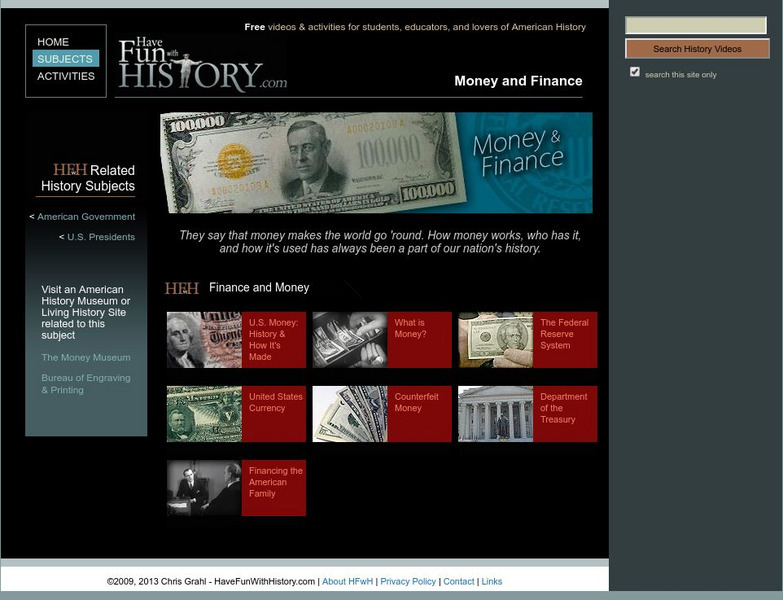Hi, what do you want to do?
Other
University of Exeter: Money in North American History
This resource provides information about money in North America from Wampum to electronic transfer.
US Mint
U.s. Mint: Circulating Coins
Read the complete history of current circulating coins. Find out about the symbols, size, and the metal composition of these coins.
Other
University of Exeter: History of Money From Ancient Times to the Present Day
A collection of fairly in-depth essays using information from a book on the history of money. Some titles include "The History of Celtic Coinage," "Money in North American History," and "Britain and European Monetary Union."
Annenberg Foundation
Annenberg Learner: American Passages: Social Realism: Edith Wharton
Drawing attention to the role of women in marriages, social differences between Europeans and Americans, old money versus new, near the turn into the twentieth century we read about author Edith Wharton. Click "Edith Wharton Activities"...
Other
Narf: Individual Indian Money (Iim) Accounts: Cobell v. Salazar
Site provides a fact sheet for Individual Indian Money (IIM) account holders. There are also answers to questions commonly asked by Individual Indian Trust beneficiaries.
Smithsonian Institution
National Museum of American History: The Coins of the Demareteion Master
The Demareteion Master is the name given to the artist who created the dies for the Demareteion coin and some others in ancient Greece. He is the first known master engraver to have lifted the numismatic art form to the level of...
Smithsonian Institution
National Museum of American History: Coins of Byzantium: The Christian Empire
This exhibit on Byzantine coins explores how the history of the Byzantine Empire is represented in its coins. There is an explanation of coin denominations, and a page listing all the rulers of the Byzantine Empire. Click on the name of...
Smithsonian Institution
National Museum of American History: Numismatic Collection: Spain and Its Coins
Read about the history of Spain through its coins, beginning the Greeks and Romans in ancient Spain, all the way up to the 20th century. Spain's long history is reflected in the examples of its coins presented here.
Smithsonian Institution
National Museum of American History: Life in Ancient Greece : Coinage of Corinth
Corinth was an important center for commerce in ancient Greece, and thus one of the first to produce coinage. This site discusses the symbolism on Corinth's coins, and presents almost two dozen examples from the Smithsonian collection.
The White House
The White House: Recovery, Your Money at Work
Explains to everyone what the American Recovery and Reinvestment Act of 2009 is meant to do, track the spending associated with the act, and provide accountability for the act.
CNN
Cnn Money: Economy in the Balance
What impact did the September 11, 2001 attacks have on the economy of the US and the global economy? This CNN Money article, written the day after the attack, assesses the already fragile condition of the US economy and speculates what...
ClassFlow
Class Flow: Learning With Money English and Spanish
[Free Registration/Login Required] This flipchart was written for a bilingual Grade 2 classroom and involves recognizing the front and back of American coins and ways to make a dollar using different denominations of coins.
American Museum of Natural History
American Museum of Natural History: O Logy: Stuff to Do: Mint Your Own Coin
The information on coins tells us a lot about the national identity of the country where it was made. Learn about the language and symbolic content of coins by creating one of your own that communicates something about your personal...
Have Fun With History
Have Fun With History: Finance and Money
Module with video, activities and links to related resources explains basic concepts of money and finance, teaching us about the role of the Federal Rerserve System, U.S. Treasury and economics of the American family.
Other
Campaign Finance: Constitutional and Legal Issues of Soft Money
This 2001 report outlines issues related to soft money in American politics. Emphasis on definitions, sources of soft money and related congressional activity.
Independence Hall Association
U.s. History: American Revolution: American and British Strengths and Weaknesses
Read a brief overview of the strengths and weaknesses of both the Americans and British in the Revolutionary War. How could such a well-funded, militarily strong country be defeated by a former colony, one with no money, little military...
Annenberg Foundation
Annenberg Learner: American Passages: Modernist Portraits: John Dos Passos
John Dos Passos is the focal point of this biography highlighting his politically charged contributions to American modernist literature. See "John Dos Passos Activities" for related artifacts and activities.
University of Illinois
University of Illinois: Early American Trade With China: American Ideas About Trade [Pdf]
American businessmen in the late 18th and 19th centuries were very interested in finding markets all over the world for their goods and actively pursuing opportunities for foreign trade. The young nation needed to earn money to pay back...
University of Groningen
American History: Outlines: A New Colonial System
Although some believe that the history of the American Revolution began long before the first shots were fired in 1775, England and America did not begin an overt parting of the ways until 1763, more than a century and a half after the...
University of Illinois
University of Illinois: Early American Trade With China: Getting Rich in the China Trade [Pdf]
The early China trade was a small but important part of the developing economy of the United States. Trade with China provided opportunities for great profits although it also carried great risk.Merchants who engaged in trade with China...
Other
Inter American Development Bank: Bolivia and the Idb
The IDB is a long-standing initiative of the Latin American countries as a multilateral finance institution for the development of the region. This site offers basic data on Bolivia as well as economic data. It also covers the...

















